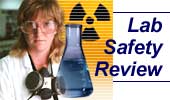LAB SAFETY REVIEW: Selecting Chemical- Resistant Lab Gloves

Written by Bruce Bahman, Technical Services, Lab Safety Supply

Lab Safety Review is a new monthly column on Laboratory Network.com. Each edition is written by a specialist in this important field.
A wide variety of chemical hazards are present in the laboratory. These can cause health problems ranging from short-term discomfort, to long-term damage to the body's internal systems and organs, to death in extreme cases.
Many chemicals enter the body through skin contact. Effective chemical process design will help to minimize this risk, but in many cases, personal protective equipment (PPE) will still be required to protect workers in the laboratory. This protection will only be valuable if care is taken to choose the correct PPE for the hazard present. In particular, gloves must be carefully selected to ensure that the environment is safe for employees.
Hazard Assessment
The first step in the selection process is a hazard assessment. The hazard assessment consists of the following steps:
- Determine which chemicals are present.
- Make a list of all hazardous chemicals used in the process. This information can be found on the material safety data sheet (MSDS) for each compound or mixture. If an MSDS is not on hand, it can be obtained from the manufacturer or distributor of the chemical or mixture.
- Consider the exposure to the chemical. Some tasks may call for only intermittent contact; others may require continuous or extended contact with the chemical.
- Determine the concentrations of the chemicals that are used.
Choosing the Proper Glove
Because different glove materials resist different chemicals, no glove is suited for all chemical exposures. Today, many chemical laboratories use only disposable latex gloves. This is unfortunate, because these gloves do not always provide sufficient protection against the variety of chemicals used in a lab. In most cases, latex gloves provide nothing more than a false sense of security for employees.
Glove selection should be based only on the glove manufacturer's chemical resistance guides or recommendations. From this information, choose the glove material that is most resistant to the chemicals being used. The actual resistance of a glove material may also vary from manufacturer to manufacturer, so make sure the selection is based on the correct manufacturer's data.
When looking at the data, there are three ratings that determine how well the glove is suited for the application:
- Degradation rating—this rating, usually listed on a scale from excellent to poor, is a measure of the physical change in a glove after chemical exposure. The better the rating, the more suitable the glove.
- Breakthrough time—the time in minutes from the contact with the chemical on the outside of the glove to the initial detection of the chemical on the inside of the glove. The longer the breakthrough time, the better the resistance.
- Permeation Rate—the rate at which the chemical passes through the glove, averaged over the test period. In this case, the lower the permeation rate, the better the resistance.
Keep in mind that the data is based on pure chemicals, not mixtures. When chemicals are combined, their physical properties and permeation rates may change. Because of this, you should base the selection on the chemical component with the shortest breakthrough time.
To learn about the eight chemical-resistant glove materials that are available for lab use and the other factors that should be considered when selecting lab gloves, read: Lab Safety Review: Pros And Cons Of Lab Glove Materials. This article will appear on Laboratory Network.com later this week.
Lab Safety Supply has a team of technical representatives who have access to the latest data available to help researchers select the most appropriate gloves for their applications.
For more information, call the Lab Safety Supply Technical Services Department at 800-356-2501.
Author Bruce Bahman can be reached at B.Bahman@LabSafety.com. Laura Vandendorpe, the managing editor of Laboratory Network.com, can be reached at lvandendorpe@vertical.net.
See Part II of this article, LAB SAFETY REVIEW: Pros And Cons Of Lab Glove Materials.
